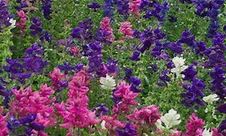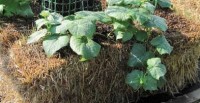By Donna Westfall
Whether you like flowers, fruits or vegetables, you can maximize your growing potential by following some solid advice during droughts.
 For color, attracting bees and butterflies, you can’t beat the salvia’s. Hint: Always add plenty of water when initially planting. The salvia’s can last for decades without much attention. You can cut them back during the cold weather, and they crop up nicely in the spring. And the deer leave it alone.
For color, attracting bees and butterflies, you can’t beat the salvia’s. Hint: Always add plenty of water when initially planting. The salvia’s can last for decades without much attention. You can cut them back during the cold weather, and they crop up nicely in the spring. And the deer leave it alone.
Straw bale gardening boils down to placing a bale on the ground, leaving the string intact and planting right into it. Using straw works much better than hay bales since they have so many seeds in them. Add soil and mulch and compost to the top of the straw bale. Think of it as a very odd type of planter that can go right on top of bare soil or lawns. It’s very cheap. One bale is typically less than the price of a bag of soil and you can put them where ever you want. But one of the best things about straw bale gardening is it’s high off the ground so you don’t have to worry about sore knees or getting up and down.
There are a few things to do first to condition your new straw bale. Once you decide on the location, put several layers of newspaper or cardboard down, If you just start watering the bale, it will decompose and heat up. That will kill your plants. It only takes about 14 days to condition your straw bale: The first three days drench your bale several times throughout the day (unless it rains and then you don’t have to do a thing). The next six days water it with a little nitrogen mixed in your water.
 Then it’s ready for planting. Bell peppers, herbs and flowers do well. You don’t want to plant tall plants like corn because it will get top heavy and may also rip the bale apart. Virtually anything else that you’d plant directly in the soil can be planted in the straw bales.
Then it’s ready for planting. Bell peppers, herbs and flowers do well. You don’t want to plant tall plants like corn because it will get top heavy and may also rip the bale apart. Virtually anything else that you’d plant directly in the soil can be planted in the straw bales.


